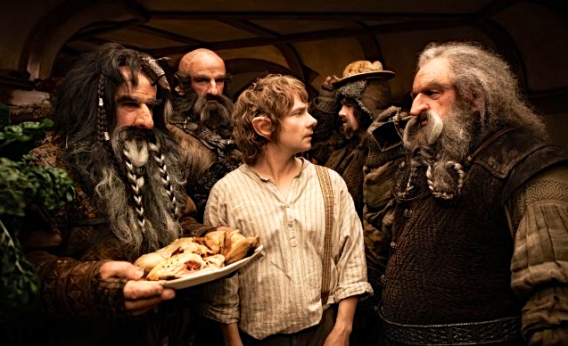In the long run-up to Peter Jackson’s adaptation of J.R.R. Tolkien’s The Hobbit, one of the buzzier bits of news to trickle out of the production was that Jackson had decided to include Galadriel (Cate Blanchett), the powerful Elvish queen of Lord of the Rings, in this new movie for the sake of gender parity. Seems that move wasn’t enough for everyone. Writing in Time earlier this week, Ruth Davis Konigsberg says that she found herself turned off by The Hobbit movie:
Tolkien seems to have wiped women off the face of Middle-earth. I suppose it’s understandable that a story in which the primary activity seems to be chopping off each other’s body parts for no particular reason might be a little heavy on male characters—although it’s not as though Tolkien had to hew to historical accuracy when he created his fantastical world. The problem is one of biological accuracy. Tolkien’s characters defy the basics of reproduction: dwarf fathers beget dwarf sons, hobbit uncles pass rings down to hobbit nephews. If there are any mothers or daughters, aunts or nieces, they make no appearances. Trolls and orcs especially seem to rely on asexual reproduction, breeding whole male populations, which of course come in handy when amassing an army to attack the dwarves and elves.
Bringing it back to Jackson, she goes on to say:
Jackson, the director of The Hobbit, has said, “To me, fantasy should be as real as possible. I don’t subscribe to the notion that because it’s fantastical it should be unrealistic. I think you have to have a sense of belief in the world that you’re going into, and the levels of detail are very important.” I should think that would include—especially in an intergenerational saga—something as important as the perpetuation of species, whether furry-footed or not.
But watching the movie, I found myself, a constant advocate for the inclusion of more female characters in fantasy, thinking it might have been better had Jackson not dragged Galadriel into The Hobbit simply for the sake of having someone with two X-chromosomes get a speaking part. In his Lord of the Rings adaptations, the enhanced roles for women like the elf princess Arwen or human noblewoman Éowyn served as reminders that strength could come from unexpected places. You could be pretty and passionately in love and still call down powerful magic against your enemies, and being a niece didn’t preclude you from defending your uncle in battle.
But Galadriel’s appearance in The Hobbit mostly feels like a checking of the box. And it reminded me that a lot of what I want in popular culture is not mandatory rainbow coalitions and gender balance in every single movie and television show, but more movies and shows that are about women and people of color—and a sense that those movies and shows aren’t only for the women and people of color depicted in them.
All-male spaces and social circles existed in the kind of medieval settings Tolkien was commenting on, they exist today, and stories that are set in those environments aren’t uninteresting to me because I’m a woman—in fact, just the reverse. My hope isn’t that they go away, but that intellectually curious men should be able to find stories about femininity, and female spaces, whether they’re fantastical or not, just as fascinating, even if there aren’t male characters in the mix.
